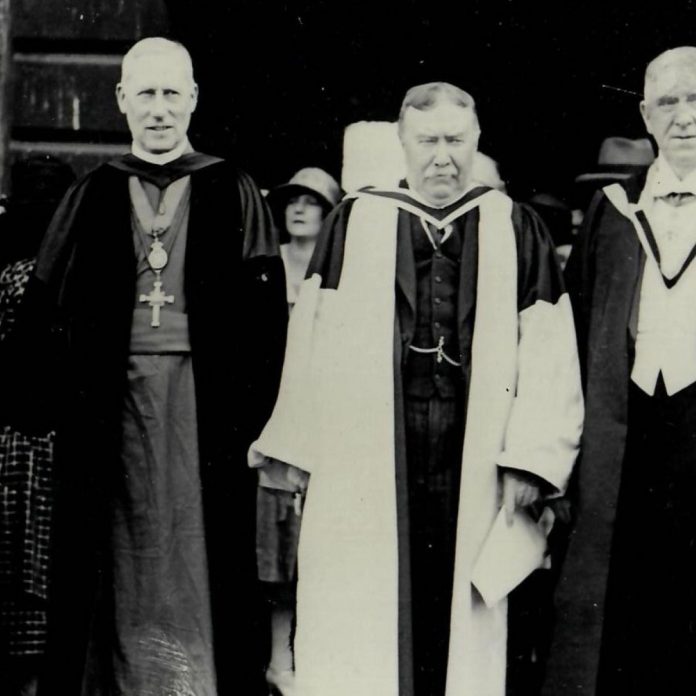The end of Chartered Rule, entrenchment of white self-government and African economic disempowerment: Currencies, and the consolidation of Racialised Economic Spaces, 1920-1930
Tinashe Nyamunda
In the previous article, I examined the currency crisis that slowed down the consolidation of white economic development in Southern Rhodesia following the disruptions in coins and other essential supplies. The article also highlighted how the use of stamped and other commercial mining and farming companies’ coupons were used as substitutes for coins. This system was abused by white commercial enterprises and threatened the already short supply of cheap African labour in ways that concerned the State. Ultimately, the state allowed banks to provide their own notes in place of coupons and coins and followed this up with other regulations limiting the outflow of gold coins from the colony.
By the 1920s, the political environment was beginning to shift. Although the British South Africa Company (BSAC)’s charter had been renewed in 1915 (until 1923), by the 1920s, questions of whether the company should continue to rule were raised. Having died in 1902, Cecil John Rhodes’ control of the company by its other members no longer inspired confidence among white settlers who desired self-rule in which they could gain more control of the colony’s politics and economy.
But as this process was taking place, a number of economic developments were also unfolding. Like Rhodesia, South Africa had faced similar challenges with the outflow of gold and melting of silver coins because of the suspension of the British gold standard. But their response went further than just regulations policing and controlling such activities. Because it had been granted dominion status (which is significant political autonomy from imperial interference) at the establishment of Union in 1910, South Africa had sufficient autonomy to establish the South African Reserve Bank (SARB) in 1920.
The creation of the SARB resulted in the introduction of coins in the Union whose value was different from the sterling then circulating in Southern and Northern Rhodesia and Nyasaland. Although causing initial challenges for trade and the payment of labor migrants into the Union, especially as South Africa demonetised (or abandoned the use of) British silver coins, Southern Rhodesia needed to determine the direction its economy would take. Because of the difference in exchange value between British silver coins and the new South African currency, a rate of exchange was established. Crucially for the Union, the creation of the SARB limited British interference and allowed the Afrikaner government, then under Prime Minister Jan Smuts, to direct the development of the settler-oriented economy.
This influenced the political inclinations of settler politicians in Salisbury. When London raised the question about how Southern Rhodesia was to be ruled after the expiration of the charter in 1923, a number of options were given. The options were the following: First, the colony could be governed directly through the colony’s office. Second, it could become a province of the Union of South Africa. The third option was the creation of a responsible government, a form of limited self-governance in which the white settlers could form a government under a constitution negotiated with Britain.
The settlers, mostly of British descent, did not want to become a province of South Africa, preferring to remain independent of Afrikaner rule and desiring to retain control of their own territory. Given the political and economic control over issues such as coinage use and banking that the British had enjoyed over Southern Rhodesia during chartered rule, settlers rejected the option of colonial office control. Unfortunately, the option of full dominion status as had been granted to South Africa was not on the table (as the white settler population of Southern Rhodesia was not nearly as significant as other Dominions such as Canada, New Zealand and Australia), the settlers opted for the next best thing. In a referendum held in 1922 in which African opinions were never solicited, Southern Rhodesian whites chose the Responsible Government option.
Responsible Government status, at least in theory, was not meant to give the settlers carte blanche control over the colony, but in practice, it gave them significant room to maneuver. While under the terms that were negotiated with Britain, the colonial government was allowed to control all aspects of policy except in three areas: The railways, African affairs and the financial system. Until the railways were nationalized in 1947, they remained under the control of the BSAC.
In a bid to protect African interests against settler interests to avoid the kind of racial domination to the levels that the Afrikaners had taken it in South Africa or the settler population had done against first nation people of Australia, London theoretically reserved the right to approve all matters of policy pertaining to Africans, but in practice, this was never strictly enforced.
In terms of currency, London reserved the right of assent to any monetary policy, and as we shall see, Southern Rhodesia could not establish any institutions of monetary management and control without Royal assent (that is, the approval of Her Majesty’s Government). So, the question of who controlled what money was to be used and how it was to be managed remained the preserve right of the British crown. So even after attaining Responsible Government status, they could not establish an institution such as the SARB. As Ian Phimister has shown in his illuminating work on Zimbabwean economic history, the 1923 constitutional compromise between Britain and Settler State was meant to accommodate imperialism.
The controversies that followed this development reflected the disparate interests between officials in the British Colonial Office and the colonial state in central Africa, particularly in Southern Rhodesia. When South Africa demonetised British silver coins, Southern Rhodesia demanded a share of the proceeds that accrued from payments made to South Africa. In contrast, officials in London insisted that Southern Rhodesia should not receive any payment but continue to use both South African and British currency as stipulated by the currency ordinance of 1891.
Interestingly, Southern Rhodesia entered into an agreement with the Union of South Africa according to which it would receive a “share of the profits on the coining of silver imported from the Union and circulating in … [its territory].” South Africa hoped to draw Southern Rhodesia into a trade relationship in which it benefited more. The legacies of this uneven relationship exist to date. This was a compromise that ensured that Southern Rhodesia would follow the law while deriving some financial benefit despite South Africa’s new currency legislation. Yet the move defied Britain’s attempts to maintain some control over currency matters in the colonies. This objective was embodied in the 1923 constitution that gave Southern Rhodesia limited autonomy under “responsible government” but precluded it from passing any law on currency matters without imperial approval.
But as the economy developed under settler rule, the government considered distancing its currency arrangements from London and contemplated a more radical solution for Southern Rhodesia. The settler government even discussed adopting the South African currency given the two countries’ close trade links. The discussion centered around moving away from south-central African connections with Northern Rhodesia and Nyasaland. These discussions are not unlike those considerations that have been made in contemporary Zimbabwe. Following the collapse of the Unity government in 2013 and the subsequent change in leadership after the ousting of Robert Mugabe by Emmerson Mnangagwa in November 2017, a number of currency dynamics almost resembling those of the 1910s and 1920s have taken place. The Bond coins and notes, this time under a Reserve Bank that has largely been referred to as a white elephant have been introduced only to result in serious failure under inflationary stress. Throughout this period, the question of joining the rand monetary area because of strong trade links has been considered. But like in the colonial period, the question of adopting a South African controlled currency has raised concerns about the maintenance of economic sovereignty. But throughout the 1920s, the possibility of adopting colonial currency was entertained, even if it was unlikely to receive Royal assent.
Within Southern Rhodesia, even as currency matters became more stabilized because of the regulations to control gold and silver coinage outflow from the colony and the Bank notes ordinance and its 1922 amendments, the question of sustainable supplies of labour still dislocated the smooth operation of settler enterprises. Even as Africans were increasingly accepting colonial currencies in larger numbers than in the first three decades of chartered rule, many could still raise the cash required for tax payment purposes through either seasonal target work, or selling their produce. Other economic activities included hunting for meat and ivory. As a result, African farmers could still compete with white businesses, and some still maintained alternative livelihoods without resorting to selling their labour. Although the African labour supply from within Southern Rhodesia had slowly increased, more labour came from migrants drafted by the Southern Rhodesian Native Labour bureau that recruited workers from Nyasaland and Portuguese-ruled Mozambique. This was viewed as unsustainable for the colonial economy and a lasting solution determining the ways in which currency could allocate economic resources had to be found.
The settler government used their legislative power to effectively disenfranchise or economically disempower Africans in a lasting way. The solution was a series of laws, the most devastating of which was the Land Apportionment Act of 1930. This Act essentially paved way for the displacement of Africans from their ancestral lands to the Reserves. Only a section of white framers who were never more than 13 percent (or 6000 people) of a white population of Rhodesia, constituting less than six percent of the population took control over, by 1979, 33 million acres of an average size of 5000 acres each. Africans, numbering well over a million, were crammed into overpopulated reserves in which they were allocated less than ten acres of unproductive land per family.
The Land Apportionment Act became the magna carta of white rule, systematically eliminating African competition and encouraging white capital accumulation. In some ways, the ways in which the post-colonial and post land reform government promoted production on the farms of ZANU PF elites who grabbed A1 farms for themselves and received the positive balance of state support through farm mechanization, inputs and capital ahead of poor rural folk and A2 farmers is in some ways not dissimilar to this process. In short, the structures, institutions and legislation that would determine how resources were distributed and wealth made was established on these foundations. That is what made Land apportionment so critical and why it was such an emotive issue during the struggle for independence in the 1960 and 1970s as well as so topical after independence.
Together with such legislation as the Industrial Conciliation Act of 1934 and others to be examined in the next article, the Maize Control Act of 1931 which was intended to protect white farmers against falling prices on the international market and priced produce of settler farmers significantly higher even for the local market compared to the international to allow their grain farming to remain viable while pushing out Africans out by setting purchase price comparatively much lower. It is to see how such arrangements allowed for the unfair and racially skewed distribution of monetary rewards for agricultural production. It also protected white farmers from the effects of falling commodity prices because of the depression from 1929 onwards. In the process, the Africans who were excluded by various means and from these initiatives were systematically driven out of the market and reduced to producing for subsistence purposes and allowed to thrive enough to allow for the reproduction of labour for the colonial economy.
With these structures in place to benefit settler farmers even under the use of British sterling, plans to adopt South African currency were abandoned. In the next article, the narrative will pick up on the subsequent stages of colonial monetary development and their implications for economic development from the the onset of the Great Depression due to the different responses by Britain and South Africa to the crisis.
But by the 1930s, Britain was consistent in its imperial monetary policies as they affected the colonies. But within Southern Rhodesia, the settlers had to imagine ways in which they could directly benefit from the colonial system. Even as Britain sought to incorporate her colonies into imperial sterling to facilitate the extraction of the region’s mineral resources, the white colonial society in Southern Rhodesia had to design a political and economic system in which they would be at the top. Africans were systematically stripped of monetary independence when legal tender regulations-imposed cash-based taxation, land was gradually seized, and they were transformed into wage laborers.
Even as London secured authority to govern an empire wide sterling network to regulate commodity prices and manage colonial markets in ways that benefited the imperial economy, the ways that money was used locally was determined by colonial power relations. The challenges of colonial monetization such as persistent coin shortages, even if they dislocated colonial business and inconvenienced settlers economically, where insufficient to make it deviate from its goal of securing the economic control of the colony and the region predicted on extracting gold, copper, agricultural commodities, among others, but only in ways in which whites were handsomely compensated. It is these foundations that lay the legacies of the region’s predominantly extractive economies which have remained significantly dependent on international markets to this day.
Another crucial point to consider is that the use of currencies and the ways in which they are introduced are never neutral. Going by the foregoing, money was never just a means of exchange, unit of account and deferred payment or a store of value. It was much more than that. It was subject to violent imperial imposition, a creature of colonial legislation and subject to political control. It was the state that used various structures, institutions and legislation to determine how money was distributed, in other words, the economics of colonial development determined who became the principal beneficiaries of the colonial economy and who would be its poorly paid labourers.
Again, like in the colonial period, much of the same elements of money are not dissimilar to how they are used even today. Questions can be asked about who gets first access to notes printed at the Reserve Bank of Zimbabwe for parallel market trade, or to those with first and easier access to foreign exchange to bring in oil and other commodities. Certainly, there are important international dynamics to consider, as follow up articles will reveal, but local currency arrangements are certainly not about money as a neutral concept. They are equally guided by questions of power, legislative imposition and considerations for those with privileged access to processes of accumulation.
As Southern Rhodesia became increasingly incorporated into Britain’s imperial monetary system through the marking of its commodities in sterling denominated currency, colonial monetization occurred as a multifaceted process engaging different layers of agency rather than as an event. The three other articles in this series have already emphasized benefits derived from the colony from connections to international markets or from the replacement of pre-colonial traditions of money. However, the story of the establishment and operation of the monetary system in Southern Rhodesia, was one of competing interests regarding the control of economic spaces and interconnected agents. These included Britain with its prerogatives on sterling management, the big mining firms and settler agriculture drew benefits from a congenial monetary system, the settler state which did its bidding for its white constituency, and Africans whose relations to colonial monetization were inherently uneven but predominantly detrimental to their collective economic welfare.
- Tinashe Nyamunda is with the African Modernities Past and Present (AMPP) research group at North West University where he is Associate Professor in Economic History.









